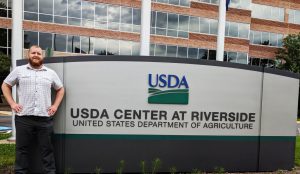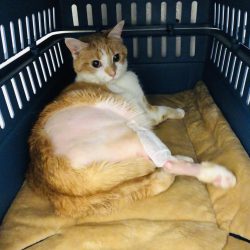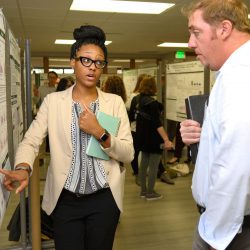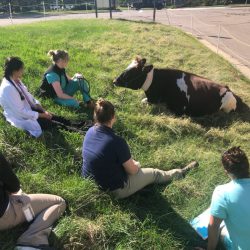
by Jonathan Teeple, DVM Class of 2020
I am a recipient of a Saul T. Wilson, Jr. Internship from the United States Department of Agriculture’s Animal and Plant Health Inspection Service (USDA APHIS). In exchange for partial tuition payments while I am enrolled in veterinary medical school, I must meet program training requirements and work a certain number of hours in exchange for guaranteed employment once I graduate.
During the summer months and other school breaks, I am employed by the USDA. My employment has given me firsthand experience in the roles that veterinarians fill in the federal government.
The National Import Export Service
My normal tour of duty is working out of the area office here in East Lansing, MI, typically as part of the National Import Export Service (NIES). One of the main focuses of NIES is facilitating the international trade and transport of animals and animal products.
The United States is a net exporter of animal products, something the general population may not often think about. There’s a huge range of items that fall into the category of animal products; obviously there’s items such as meat and milk, but also more obscure items like serum from research animals being sent to collaborators abroad, chicken feathers, animal hides, and even manure. Dedicated individuals in the NIES serve as our government’s interface in maintaining awareness of other countries’ testing requirements for any animal products entering their country.
In my role, I serve businesses and individuals that are traveling with animals outside of the United States. I spend a lot of time talking to animal owners and veterinary clinics, helping ensure they have all the vaccinations, testing, and treatments done that their country of destination requires.
Some countries are extremely strict about the amount of testing they require for animals, but in my experience, it tends to be because they are making sure their country stays free of diseases that are not currently endemic there. Failure to comply with a country’s animal import requirements can result in your animal being sent home, placed in quarantine, or even euthanized, so, we always work to ensure everyone’s testing, vaccinations, and documentation are in order.
Response to Exotic Newcastle Disease
Near the end of the summer in 2018, I had the opportunity to take part in a deployment to the Inland Empire in southern California. Earlier in the season, a veterinary clinic reported to their state veterinarian that they suspected a client’s bird was suffering from the virulent form of Newcastle Disease (also known as Exotic Newcastle Disease). Samples were sent to the state and national laboratory for testing. Upon getting a presumptively positive test result from the California Animal Health and Food Safety laboratory and a confirmatory test from the National Veterinary Services Lab in Ames, IA, a national response was quickly initiated.
The four main elements to the response effort:
1) Headquarters Unit
This team is made up of USDA personnel from across the country, who are part of preformed teams that deploy together in the event of an outbreak like this. They facilitate every thinkable aspect of the response effort: IT, logistics, epidemiology, personnel, public relations, and planning. The response effort is directed locally by this team; they carry out the day-to-day task of coordinating all the other fronts of the response effort.
2) Surveillance Unit
This is the largest part of the response in terms of manpower. This unit really had the biggest task in the response—canvasing neighborhoods in and around the area that the disease was thought to be circulating in. Their main mission for this response was to find residents who had pet birds or backyard poultry. They would then set up the next unit to come in and do testing.
3) Diagnostics Unit
This unit went to homes that would allow testing of their birds. Before stepping on the premises, the diagnostics teams would don appropriate personal protective equipment (PPE) to ensure they were not going to be the cause of further disease spread between sites. The PPE consisted of dual layers of booties, a Tyvek jumpsuit, a double layer of gloves, eye protection, and a bonnet. The number of birds on the premises would determine the number of samples that would need to be taken, up to a maximum of 50 samples.
4) Depopulation Unit
If testing came back positive, the depopulation unit came through to quickly and efficiently euthanize the birds on the premises. I was assigned to this unit, and was initially hesitant to euthanize these animals. Then, I witnessed chickens suffering from the fulminant symptoms of the disease: nasal and ocular discharge, difficulty breathing, severe diarrhea, and neurologic signs. Observing the full effects of the virus made it a lot easier to participate in the duties of the depopulation unit.
Since my time at the Inland Empire in southern California this summer, the outbreak has continued to spread around the same area in southern California. The Newcastle virus has continued to circulate through backyard poultry, but there also has been spillover into a handful of commercial flocks. Preventing the further spread of the outbreak into commercial poultry units is really the critical aspect of this outbreak response. There was an outbreak of Newcastle disease in southern California in 2002–2003, which got into commercial operations and spread to 5 states. More than $180 million was spent to control that outbreak.
Through my past two summers working with the USDA APHIS, I have been exposed to many of the different facets of the roles veterinarians play in the federal government. There are numerous avenues for veterinarians to engage: foreign animal disease detection, animal import inspections, facilitation of trade of animals and animal products to international markets, disease prevention and traceability, and animal health monitoring.
It is a career that will be demanding and require me to stay educated and at the top of my game. I am wholeheartedly looking forward to continuing my work upon graduation.



